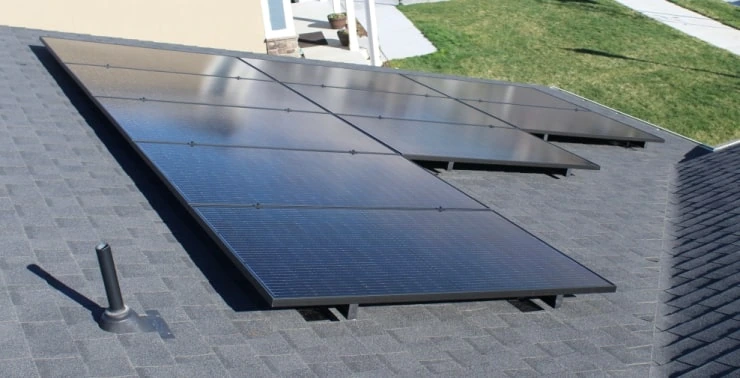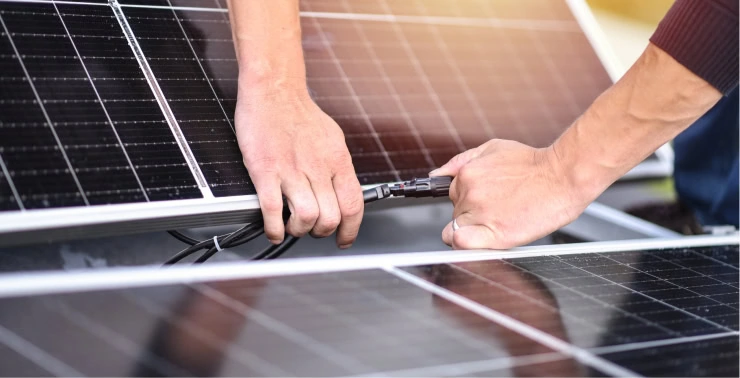
Everyone knows that solar energy is a great idea. They know it’s green energy. They know it’s a powerful way to offset rising utility costs. But, do they really understand how solar power works? How do we take energy from sunlight and turn it into electricity, and what does it take for a homeowner to set their home up with a solar panel system?
You would need an engineering degree to really understand all of the nuances of solar panels and how they work. But that’s not why we’re here. This simple breakdown will explain the basics that Connecticut solar shoppers need to know in order to make the best decision for their homes and lifestyles.
How it Works
Some people might think that the sun’s energy is captured and turned into electricity, but that’s not actually the case. But, believe it or not, the concept of how solar panels produce electricity is actually quite simple.
Photovoltaic Cells
Converting sunlight into usable electricity starts with the solar panels. Solar panels contain tiny solar cells. These cells are typically composed of silicon. As the sun’s rays strike the solar system, these cells heat up, causing them to start moving and dancing. As the cells move faster and faster, they begin to create electrical current (this is called the photovoltaic effect).
Also inside these solar panels are two semiconductors (positive and negative). They form what’s known as a P-N junction. In simplest terms, this junction is basically like a gate that pushes the usable energy toward an electrical circuit.
Solar Inverters
The issue with this energy is that it’s DC, or direct current, and homes need AC, or alternating current. So, energy passes through an inverter which converts the energy to usable AC. Inverters are critical to a solar energy system, otherwise, even the largest systems wouldn’t be able to power a home’s needs.
There are two types of inverters available for solar energy systems. The first type is the string inverter, which is very common, but they require the panels to operate as one unit rather than individually. The other type of inverter is a microinverter, which allows panels to work independently and produce varying amounts of energy based on the sunlight each individual panel experiences, improving efficiency.
System Disconnects and Meters
Once the solar energy is converted to AC power, it passes through disconnect switches before tying into the home’s grid. There is often a meter, as well. This allows the homeowner, electricians, or solar installers to isolate the solar system when working on the home’s electrical system. Net metering allows the utility company to track solar production and provide homeowners with a credit.
Solar Power Storage
Typically, the energy flows from the solar panel system, through the inverters, through the disconnects and meters, and into the house’s system or through the power grid. In some cases, this can lead to wasted energy for the homeowner—especially if the system produces more energy during the day than it uses, and nothing at night. Solar power storage systems solve this issue.
After the solar energy passes through the disconnects, it’s directed to the solar batteries. The solar batteries capture the energy where it can be stored for use at night or even if the power is out. This allows the homeowner to take advantage of more of the clean energy produced by installing solar panels and lowering energy costs.
Solar in Connecticut
Solar in Connecticut is a great fit. On average, the state sees between 150 to 180 good solar days (these are days with clear skies or mostly sunny skies). Summer is obviously the best, when the days are the longest and the sun’s rays are the most intense. Fall and spring are also good times for solar production, though there are often rainy days when solar systems aren’t as efficient as they can be. Winter’s shorter days are the least productive, though they can still be great solar production days.
There are more reasons to take on a solar project than simply the energy savings alone. Connecticut residents can also take advantage of some state and federal incentives and tax benefits. For example, the Investment Tax Credit allows homeowners to deduct up to 30% of the cost of their solar systems. Also, some local municipalities may offer credits, as do some local utility companies.
Benefits of Solar Power
Customers considering solar panel renewable energy systems should familiarize themselves with their benefits.
Clean Energy Production
Producing clean energy is by far the biggest benefit. It reduces a household’s reliance on fossil fuels, decreases greenhouse gas emissions, lowers the family’s carbon footprint, and helps combat climate change.
Reduced Electricity Costs
One of the main reasons homeowners consider solar is to reduce their electricity bills. The supplemental energy produced by the solar panels is credited toward the homeowner’s electrical usage, reducing the overall price once the utility bills roll in.
Power Stability
A well-designed solar panel system can help stabilize power for some homeowners (particularly those in areas where power frequently fails). Not only can the power from the panels be used during the day even if the grid is out, but energy can also be stored in the solar batteries and used when energy is out, allowing the solar system to function like a backup system.
Increased Home Value
In many cases, a home’s solar panel system can actually increase its value. A system can increase the value by roughly 5%, allowing homeowners to recoup some of the costs associated with installing their solar panels system.
Solar Options
There are a few solar system options that homeowners should consider. Ideally, they’ll have a roof with a clear line of sight between the home and the sun. Usually, this means a roof plane that faces south. This allows the homeowner to have solar panels installed on their roof and take advantage of the sun’s energy throughout the entire day.
In cases where roof planes face east and west, other than mid-day, it makes more sense to install solar panels on each plane. With microinverters, these systems can be very efficient despite not having full sun all day.
Solar arrays can be installed on flat roofs. They’re basically stands that are installed on the roof and pitch the solar panels toward the sun to capture as much sunlight as possible. Solar arrays can also be installed in yards or fields when the home doesn’t have a clear line of sight to the sun or the homeowner doesn’t like the look of solar panel systems.
How to Get Started
If you’re getting serious about solar, contact Shedd Energy today. We’re Connecticut’s best solar installer, helping homeowners lower their energy costs, reduce their carbon footprint, and take advantage of tax incentives across the state. Our solar experts will help you learn as much as possible about solar and choose the best possible options for your home.
Not only is Shedd at the top of the list of Connecticut solar resources, but we also encourage homeowners to consider all their financing options. We will help them secure a solar loan to pay for their system, helping them take advantage of tax incentives and save money through rebates and more.
If you think it’s time to stop letting sunshine slip through your fingers, contact Shedd Energy today.

